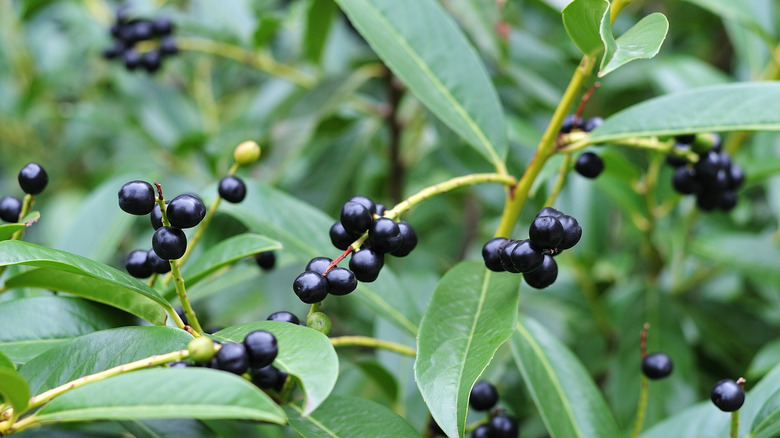The Type Of Cherry Laurel Tree That Attract Beautiful Robins To Your Backyard
If you're keen to attract songbirds like beautiful robins to your backyard, grow trees and shrubs that will provide food and shelter for these delightful feathered friends. You'll find that inviting these birds into your yard might even end your cockroach problem if you have one. One tree species to consider is a type of cherry laurel tree that's native to the southern U.S. states. The Carolina cherry laurel (Prunus caroliniana) is a small evergreen tree with lovely glossy green leaves that have a distinctive cherry fragrance when you crush them. It can be successfully grown in USDA hardiness zones 7 through 10.
What makes this tree so attractive to robins and other songbirds are the clusters of dark black berries that appear from September to October. Once ripe, these fruits are a great food source for a variety of different songbirds, as well as small mammals. In fact, did you know that black is one of the major colors that will attract robins to your garden?
As a bonus, before the fruit appears, the small, white, fragrant flowers attract pollinators such as bees and butterflies, and the tree provides winter protection for many of the birds that visit your garden. The tree is also host to the larvae of the eastern tiger swallowtail butterfly. It should be noted though: the leaves, stems, and seeds of this tree are toxic to humans and pets.
How to grow a Carolina cherry laurel tree in your backyard
The Carolina cherry laurel can either be planted as a lone tree or you can plant several in a row and prune them into a hedge. This cherry laurel will grow either in sun or shade, but should be planted in well-drained soil because waterlogged soils will kill the tree. This tree has surface roots, so it needs to be well-watered after planting and while young.
As the tree grows and matures, it becomes quite drought tolerant and shouldn't need supplementary watering. One thing to watch out for is the small seedlings that will pop up in the soil around the base of the tree from the seeds that are dropped. These seeds will germinate quite readily, so you'll need to pull up the seedlings as they occur.
Once established, this tree is virtually maintenance-free and grows very fast. Watch out for those black berries if you plant this next to a path or driveway, because they will make a mess. However, they can be easily washed away if necessary. If you're planning to grow this lovely tree in your garden to attract robins, you might also like to explore other birdscaping tips to turn your yard and garden into a bird haven.

